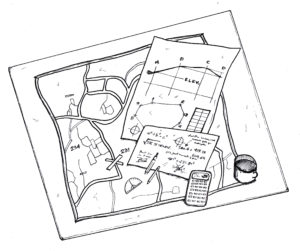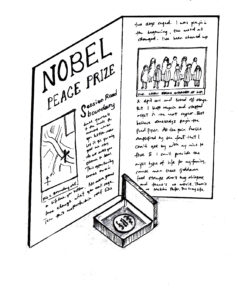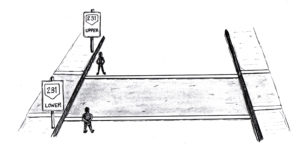Contrary to popular belief, the break actually began the moment the scientists declared the exact point had been found. Initially, the city responded with such joy that one would have thought all of humanity’s problems had vanished. Elders openly wept at the discovery, overcome with ecstasy that the conundrum had resolved in their lifetimes. Children sang in unison on sidewalks. Young men danced, and cha-cha’d on the streets. High-fives echoed all around. Finally—after decades of uncertainty— everyone knew exactly where the boundary between Upper and Lower Session existed.
 Using the most advanced techniques in “boundary-determining,” the multi-national team of scientists pooled their brainpower—and hired a relationship expert who helped guide them in determining what and where the “boundary” was. With results so precise, physicists mapped the split at the atomic level and immediately went to work drafting new theories in space-time relativity, claiming that the boundary was proof that we humans indeed had the capability of creating new semi-unnecessary divisions in an otherwise routine roadway.
Using the most advanced techniques in “boundary-determining,” the multi-national team of scientists pooled their brainpower—and hired a relationship expert who helped guide them in determining what and where the “boundary” was. With results so precise, physicists mapped the split at the atomic level and immediately went to work drafting new theories in space-time relativity, claiming that the boundary was proof that we humans indeed had the capability of creating new semi-unnecessary divisions in an otherwise routine roadway.
The entire operation had taken a total of twenty years, or five mayoral terms, (all of which were occupied by Mauricio Domogan.) By the end of it all, Baguio as a collective hailed the scientists as heroes of the New Age. Parades celebrated their greatness. Statues were erected in their honor. Even Rizal Park by City Hall was rechristened to one of the scientists’ names instead.
 “Alowishus Devadander Park” had more of a ring to it, claimed those who voted for the measure.
“Alowishus Devadander Park” had more of a ring to it, claimed those who voted for the measure.
With a city in hysteria, the exact line of delineation morphed into a tourist attraction. Entrance fees ranged from P50 for a view of the line from ten feet away, to P2,000 for an opportunity to touch the sacred concrete section at which the division lay. Gift shops opened, and souvenir shirts with tired jokes spread like wildfire across town. Lines like “I don’t take downers, because I’m an Upper Session man.” and “100% Certified Uptown Girl” plastered themselves upon chests and backsides everywhere.
The festivities were fun… until the shine wore off, and personalities began to take things to the next level.
The once-innocent Upper Session and Lower Session fan clubs devolved into warring factions, with one side claiming to be the “one, true, superior, and unadulterated” Session. Folks who—by pure random happenstance— lived on the upper half considered themselves “true highlanders” simply by virtue of the name. Those on the lower side of town meanwhile busied themselves with claims they were more down-to-earth and had less of an “ere” than those on the other side. Each side began to discriminate against those who had even the remotest connections to the opposite Session.
“Ay… taga-upper gayam ni father mo? Imbag ta nagmana ka ken mother mo.” came the passive-aggressive compliment from someone on the south side.
However, even with all this, no one had it worse than those who chose neither. Tried and judged as guilty of apathy and indecision, hordes of locals fled north to the mountains. Atok’s population census reported a 9000% percent growth in the weeks that followed the escalation in border tensions, with the majority of new “immigrants” utterly dumbfounded at the intensity of passions over an imaginary line on the ground.

The break persists to this day—with a massive wall erected directly over the delineation. Fortified and guarded by barbed wire fences, surveillance cameras, and 24-hour sentries, no one is allowed passage from one side to the other under any circumstance. For good measure, wagwagan stalls with absurdly high prices were set-up all around the wall because apparently nothing keeps a local away than a terrible bargain.
Copyright © 2018 Cousin from Baguio
